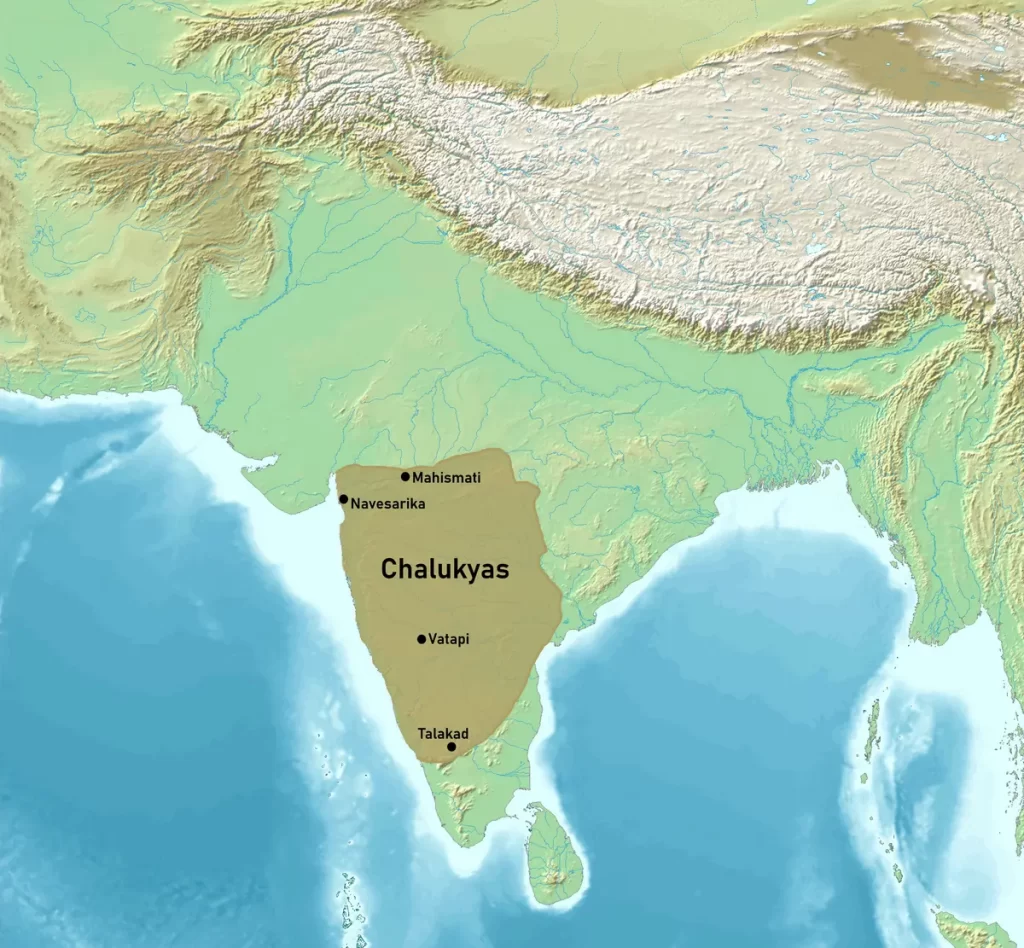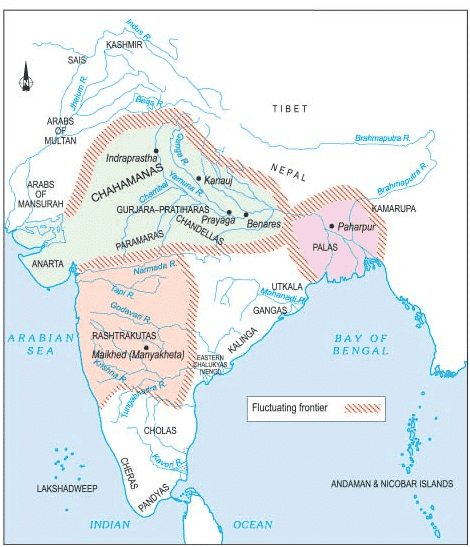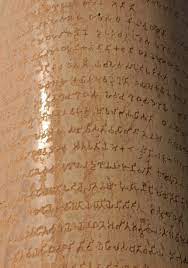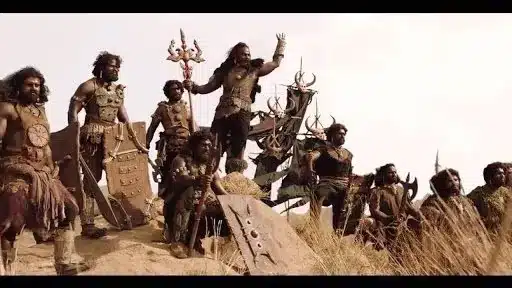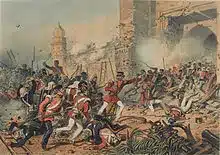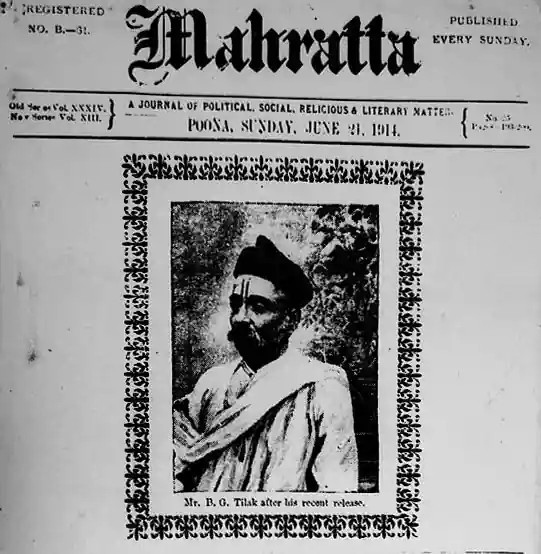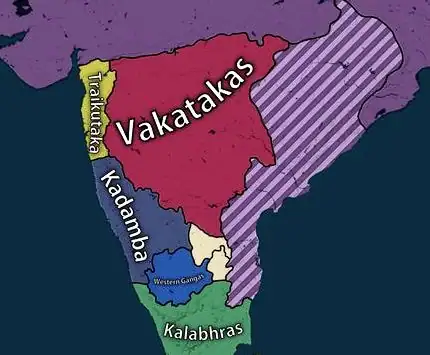Pushyabhuti Dynasty| Harshavardhana
After the decline of the Guptas dynasty north India again split up into several kingdoms. The Hunas established their supremacy over Kashmir, Punjab and western India from about A.D. 500 onwards. North and western India passed under the control of about half a dozen feudatories who parcelled out Gupta empire among themselves.
Gradually one of these dynasties ruling at Thanesar (near Kurukshetra in Haryana) extended its authority over all the other feudatories. The ruler who brought it about was Harshavardhana (A.D. 606-647).
- The source for information about the rise of the family of Pushyabhutis which first ruled from Thaneshwar in Haryana and later from Kanauj in Uttar Pradesh included the text Harshacharita, a biography of Harsha written by Harsha’s court poet Banabhatta, accounts of Hieun Tsang and some inscriptions and coins, etc.
- According to Banabhatta the founder king of this dynasty at Thaneshwar was Pushyabhuti and that the family was known as Pushyabhuti vamsa.
- However, the inscriptions of Harsha make no reference of Pushyabhuti.
- The Banskhera and Madhuvan plates and royal seals mention five earlier rulers among whom the first three are given the title of maharaja. This may indicate that they were not sovereign monarchs.
Prabhakar Vardhana (around mid-6th century CE)
The fourth king Prabhakarvardhana has been described as a Maharajadhiraja which makes means that he was an independent monarch and had established matrimonial relations with the Maukharis by marrying his daughter Rajyasri with Grahavarman. He established important marital alliances with the Maukharis of Kanyakubja/Kannauj (their neighbours to the east) by marrying his daughter Rajyashri to the Maukhari ruler Grahavarman.
- Thaneshwar, during this time (about 604) was threatened by the Hunas from the western side. Banabhatta has described Prabhakarvardhana as “a lion to the Huna deer”.
- According to him an army under Rajyavardhana was sent to defeat the Hunas but due to the sudden illness of his father, he had to come back.
- Rajya Vardhana had succeeded Prabhakar Vardhana initially. However, Harsha succeeded his brother, when Rajya Vardhana left the reigns of governance in the hands of Harsha Vardhana as he had to undertake a campaign against the ruler of Malwa, Devagupta and Shashanka, the ruler of Gauda, who had imprisoned their sister Rajyashri and killed her husband Grahavarman.
- He defeated the Malwa army and killed Devagupta, but was unfortunately killed by Shashanka, who also cut the Bodhi tree and occupied Kannauj.
Harsha Vardhana ( c. 606−647 CE)
It was under these circumstances that Harsha a 16-year-old ascended to Thanesar’s throne in 606 AD. Although he was only sixteen years of age at that time, still he proved himself to be a great warrior and an able administrator. He immediately marched towards Kannauj and rescued his sister Rajyashri, who was believed to be on the verge of committing Sati.
He promised to avenge his brother’s death while also saving his sister. For this, he formed an alliance with Kamarupa King Bhaskaravarman. Harsha and Bhaskaravarman go out to confront Sasanka. Sasanka eventually fled for Bengal, and Harsha became the ruler of Kannauj as well. Later, he also defeated Shashanka and extended his control over parts of Kongoda in Orissa.
About Harsha
- Harsha was the son of Prabhakaravardhana, the Pushyabhti king of Thanesvar. Harsha’s mother was Yasomati.
- Durgavati was his wife.
- He has two boys and a daughter. His daughter married a Vallabhi monarch, but his sons were murdered by his own minister.
- He was described as the lord of the north (sakalauttarapathanatha).
- He was considered the last great emperor in ancient Indian History.
- He assumed the title of ‘Siladitya’, as mentioned in travel records of Chinese traveler Xuanzang (Hsuan Tsang).
- He also conducted Dharmayatras like Samrat Ashoka.
Harsha and Buddhism
- Harsha was originally a Shaiva but later he was converted to Mahayana Buddhism by the Chinese Buddhist pilgrim, Hieun Tsang.
- He conducted the Buddhism conferences called Sangeethis at Prayag at the end of every five years and also held the Mahamoksha Parishad. This was done to promote Mahayana Buddhism.
- Harsha prohibited the use of animal food in his kingdom and punished those who kill any living being.
- He erected thousands of stupas and established travellers’ rests all over his kingdom.
- He also erected monasteries at the sacred places of Buddhists.
- Once in five years he convened a gathering of representatives of all religions and honoured them with gifts and costly presents.
- He brought the Buddhist monks together frequently to discuss and examine the Buddhist doctrine.
Kanauj Assembly
- Harsha organized a religious assembly at Kanauj to honour the Chinese pilgrim Hiuen Tsang towards the close of his reign. He invited representatives of all religious sects.
- It was attended by 20 kings, 1000 scholars from the Nalanda University, 3000 Hinayanists and Mahayanists, 3000 Brahmins and Jains.
- The Assembly went on continuously for 23 days.
- Hiuen Tsang explained the values of Mahayana doctrine and established its superiority over others.
- However, violence broke out and there were acts of arson and there was also an attempt on the life of Harsha. Soon, it was brought under control and the guilty were punished.
- On the final day of the Assembly, Hiuen Tsang was honoured with costly presents.
Prayag Conference
- Hiuen Tsang mentions in his account about the conference held at Allahabad, known as Prayag.
- It was the one among the conferences routinely convened by Harsha once in five years.
- Harsha gave away his enormous wealth as gifts to the members of all religious sects.
- According to Hiuen Tsang, Harsha was so lavish that he emptied the treasury and even gave away the clothes and jewels he was wearing. His statement might be one of admiring exaggeration.
Hieun Tsang about Harsha
- The Chinese pilgrim Hsuan Tsang, who is also known as the Prince of Travelers and author of Si-Yu-Ki, visited India during 629–644 CE.
- He earned Harsha’s friendship and left a vivid account of the beauty, grandeur, and prosperity of Kannauj.
- He gives a detailed account of a grand assembly held at Kannauj in 643 CE, which was attended by the representatives of Hinduism, Jainism, and Buddhism, in which Xuanzang along with others gave discourses on Mahayana doctrines. This grand conclave was also attended by various subordinate kings including those of Vallabhi and Assam.
- A huge tower with a golden statue of the Buddha was constructed for the occasion, which was later worshipped by Harsha himself.
- Some of the subordinate rulers who had titles such as samanta and raja used the Harsha era of 606 CE, which was the year of the accession of Harsha Vardhana.
Military Campaign of Harsha
- Harsha’s reign was marked by many military victories and he brought most of north India under his control as he brought the five ‘Indies (regions)’ — Punjab, Kannauj, Bengal, Orissa, Mithila.
- In his first expedition, Harsha drove out Sasanka from Kanauj and made it his new capital. This made him the most powerful ruler of north India. Harsha fought against Dhuruvasena II of Valabhi and defeated him. Dhuruvasena II became a vassal.
- The most important military campaign of Harsha was against the Western Chalukya ruler Pulakesin II. Both the accounts of Hiuen Tsang and the inscriptions of Pulakesin II provide the details of this campaign. Harsha with an ambition to extend his kingdom south of the Narmada river marched against the Chalukya ruler. But the Aihole inscription of Pulakesin II mentions the defeat of Harsha by Pulakesin.
- Pulakesin after this achievement assumed the title Paramesvara. Hiuen Tsang’s accounts also confirm the victory of Pulakesin.
- Harsha led another campaign against the ruler of Sindh, which was an independent kingdom.
- Nepal had accepted Harsha’s overlordship.
- Harsha established his control over Kashmir and its ruler sent tributes to him.
- He also maintained cordial relations with Bhaskaravarman, the ruler of Assam (Kamarupa).
- Harsha’s last military campaign was against the kingdom of Kalinga in Orissa and it was a success.
- The forest tribes of the Vindhyas too regularly paid tribute to Harsha and also helped him with military support.
- Thus Harsha established his hold over the whole of north India. The regions modern Rajasthan, Punjab, Uttar Pradesh, Bihar and Orissa were under his direct control. But his sphere of influence was much more extensive.
Administration under Harsha
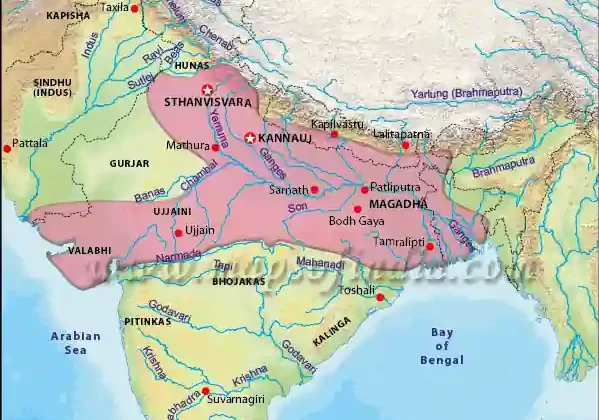
Harsha governed his empire on almost the same lines as the Guptas, except that his administration was more feudal and decentralized. The leading feudatories of Harsha were Bhaskaravarmana of Kamarupa, Dhruvabhatta of Vallabhi, Purnavarman of Magadha, and Udita of Jalandhara.
Harsha kept up a productive government operation. Mahasamanta, Pramatara, or the spiritual teacher, Maharaja, Kumaramatya, Rajasthaniya, Vishayapati, and other top officials were among those who directly received directives and orders from the king. The Chief Commanding Officer, the Cavalry Commanding Officer, and the Elephant Forces Commanding Officer were present.
Important officers of Harsha’s administration:
- The ‘sreshti’ (Chief Banker or Merchant)
- The ‘sarthavaha’ (Leader of Merchant Caravans)
- Prathama kulika (Chief Craftsman)
- Kayasthas (head of the scribes)
He had the support of a large army, which was also supplemented by contributory forces from feudatories in times of need. It is stated that Harsha had 100,000 horses and 60,000 elephants. This seems to be astonishing because the Mauryas, who ruled practically the whole of the country except the deep south, maintained only 30,000 cavalry and 9,000 elephants.
Harsha could possess a larger army only if he could mobilize the support of all his feudatories at the time of war Evidently every feudatory contributed his quota of foot soldiers and horses, and thus made the imperial army vast in numbers. The power shifted to military camps known as skandhavaras.
Tax policy was liberal. The royal share was one-sixth of agricultural production. Taxes depend on the weight and measure of goods sold and on the share of production, taxes, and cash payments from other sources of income. Revenue was also derived from trade and commerce. But the duties on goods were mild.
Land grants to priests in lieu of their special services continued and it is generally presumed that land grants to officers by charters in lieu of their salary probably began with Harsha (as evident in the lesser number of coins issued by Harsha). These grants contained the same privileges as enjoyed by Brahmadeya lands. Hsuan Tsang states that people were taxed lightly and the revenues were divided into four parts :
- One part was earmarked for the king
- The second part was reserved for scholars
- Third part for the endowments of officials and public servants
- Fourth part for religious purposes
Harsha personally supervised the administration and according to the records of Hieun Tsang, he divided his day into three parts: attending to administrative duties during the first and devoting himself to religious work during the other two. He used to have frequent tours of inspection around his kingdom.
However, law and order suffered from some lacunae as inferred from the travel statements of Hieun Tsang, wherein he states that he was robbed as well. The laws of the land were severe and generally robbery was considered as second only to treason, for which the right hand of robber was amputated. But, later it appears under the influence of Buddhism, the severity of punishment was mitigated and criminals were punished for life.
The Brahmanas and Kshatriyas were reported to lead a simple life, but the nobles and priests led a luxurious life.
The Shudras were generally agriculturists and their status improved as compared to past. Earlier, they were meant to serve the other three varnas only, but they could now pursue agriculture independently. However, the state of untouchables such as the Chandalas continued to be pathetic and they suffered from all forms of disabilities.
The forest guards were known as the Vanapalas and the chief of all the villages was an officer called sarva-palli-patti.
Hieun Tsang pointed to the disintegration of the Buddhist sect into eighteen sects. However, Nalanda emerged as a great centre of Buddhist studies and had a huge monastic establishment.
Another Chinese traveller Yijing/I-Tsing also visited India in 670 CE and lived for ten years at the Nalanda monastery. He describes that Nalanda was supported by the revenues of 200 villages.
According to the Chinese pilgrim Hieun Tsang, the revenues of Harsha were divided into four parts. One part was earmarked for the expenditure of the king, a second for scholars, a third for the endowment of officials and public servants, and a fourth for religious purposes.
Society and Economy under Harsha
Division of Society
- Both Bana and Hiuen Tsang portray the social life in the times of Harsha.
- The fourfold division of the society – Brahmin, Kshatriya, Vysya and Sudra – was prevalent.
- The Brahmins were the privileged section of the society and they were given land grants by the kings.
- The Kshatriyas were the ruling class.
- The vysyas were mainly traders.
- Hiuen Tsang mentions that the Sudras practiced agriculture.
- Both Bana and Hiuen Tsang talk about the existence of many subcastes such as the class of vernacular poets, class of bards, class of betal-bearers, and so on. However, all those groups and subcastes were not new to this period and at least some of them existed in the earlier periods.
- The rise of those subcastes was due to the social violation in the code of marriages and general ethics, and also different occupations
- Hiuen Tsang takes note of many outcastes and untouchables such as butchers, fishermen, executioners and scavengers, who were segregated and were not allowed to mix with the people of the higher varnas and had habitations marked by a distinguishing sign.
Position of Women
- The position of women was not satisfactory.
- The institution of Swyamvara (the choice of choosing her husband) had declined.
- Remarriage of widows was not permitted, particularly among the higher castes.
- The system of dowry had also become common.
- The practice of sati was also prevalent. Hiuen Tsang mentions three ways of disposal of the dead – cremation, water burial and exposure in the woods.
Trade and Commerce
- The trade and commerce had declined during Harsha’s period. This is evident from the decline of trade centres, less number of coins, and slow activities of merchant guilds.
- The decline of trade in turn affected the handicrafts industry and agriculture. Since there was no large scale demand for goods, the farmers began to produce only in a limited way.
- This led to the rise of self-sufficient village economy.
- In short, there was a sharp economic decline as compared to the economy of the Gupta period.
Art and Culture under Harsha
Harsha was a great patron of the arts and learning. He was very talented himself as it is believed that he wrote three dramas Priyadarshika, Ratnavali (both romantic comedies), and Nagananda (based on Bodhisattva Jimutavahana). He also has to his credit a work on grammar and two Sutra works. It is presumed that he himself composed the text of the two inscriptions Madhuban and Banskhera (they contain his signature and exhibit his calligraphic skills).
His biographer Banabhatta adorned his royal court. Besides Harshacharita, he wrote Kadambari. Other literary figures in Harsha’s court were Matanga Divakara and the famous Barthrihari, who was the poet, philosopher and grammarian.
According to Banabhatta, he was also an accomplished flute player.
He established a large monastery at Nalanda. Banabhatta (author of Harshacharita and Parvatiparinay), Mayura (author of Mayurashataka), renowned grammarian Bhartrihari (author of Vakapadiya), and Matanga Divakara were the accomplished writers at his court.
He had diplomatic relations with the Chinese as his contemporary T’ang Emperor sent three embassies to his court. The last of these, under Wang-hiuen –tse, came to India in 647 CE when Harsha was no longer alive.
The art and architecture of Harsha’s period are very few and mostly followed the Gupta style. Hiuen Tsang describes the glory of the monastery with many storeys built by Harsha at Nalanda. Hiuen Tsang also speaks of a copper statue of Buddha with eight feet in height. The brick temple of Lakshmana at Sirpur with its rich architecture is assigned to the period of Harsha.
Decline of Harshavardhana
- Harsha died in 647 AD, having reigned for 41 years.
- His dominion fell quickly after his death since he died without successors.
- Following Harsha’s death, there was a period of political turmoil until the advent of Yashovarman in 715-45 CE.
- The tripartite battle between the Rashtrakutas, Palas, and Gurjara-Pratiharas for the control of Kanauj was a prominent component of the period’s political history.
Also, refer to the following,

